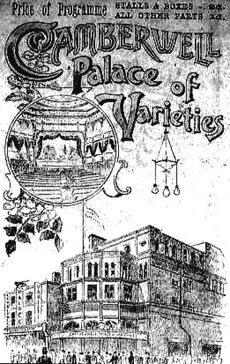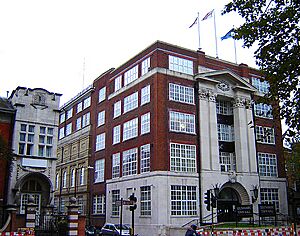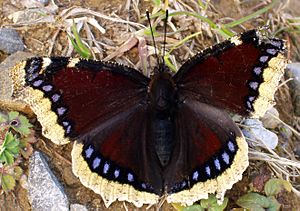Camberwell facts for kids
Quick facts for kids Camberwell |
|
|---|---|
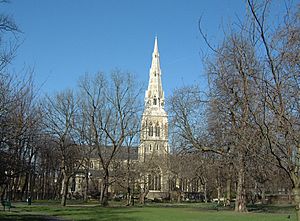 St Giles' Church, Camberwell |
|
| OS grid reference | TQ325767 |
| • Charing Cross | 2.7 mi (4.3 km) NW |
| London borough | |
| Ceremonial county | Greater London |
| Region | |
| Country | England |
| Sovereign state | United Kingdom |
| Post town | LONDON |
| Postcode district | SE5 |
| Dialling code | 020 |
| Police | Metropolitan |
| Fire | London |
| Ambulance | London |
| EU Parliament | London |
| UK Parliament |
|
| London Assembly |
|
Camberwell (/ˈkæmbərwɛl/ kam-BƏR-wel) is an area in South London, England. It is part of the London Borough of Southwark. Camberwell is about 4.4 kilometers (2.7 miles) southeast of Charing Cross, a central point in London.
Camberwell started as a small village. It grew around the church of St Giles. It also had a common area, like a village green, called Goose Green. This old parish included nearby places like Peckham, Dulwich, Nunhead, and part of Herne Hill. Before 1889, Camberwell was part of the county of Surrey. In 1900, the original parish became the Metropolitan Borough of Camberwell.
In 1965, most of the Borough of Camberwell joined to form the London Borough of Southwark. Some parts of West Dulwich and Herne Hill are now in the London Borough of Lambeth.
Today, the area known as Camberwell is smaller than the old parish. It is bordered by Walworth to the north. To the south are East Dulwich and Herne Hill. Kennington is to the west, and Peckham is to the east.
Contents
History of Camberwell
Camberwell is mentioned in the Domesday Book as Cambrewelle. This was a very important survey of England in 1086. The name might come from an old English word. It could mean 'Well of the Britons'. This would refer to the Celtic people who stayed in the area. Most people around them were Anglo-Saxons.
Another idea is that the name means 'Cripple Well'. This suggests it was a place where sick people were sent from City of London. They might have gone there for treatment. The church and clean water from wells were thought to help them. Springs and wells were known to be on the southern slope of Denmark Hill.
Camberwell was already a big settlement with a church by the time of the Domesday Book. It was the main church for a large area. This included Dulwich and Peckham. Up until the mid-1800s, Londoners visited Camberwell. They liked its quiet countryside and its healing mineral springs. But like many parts of South London, Camberwell changed a lot. This happened when railways arrived in the 1860s.
The main crossroads in Camberwell is Camberwell Green. This is a small area of common land. It used to be a traditional village green. An old annual fair was held there. It was as popular as the fair in Greenwich.
Local Government in Camberwell
The Parish of Camberwell
Camberwell St Giles was an old parish in Surrey. It covered about 18.5 square kilometers (4,570 acres) in 1831. The parish was divided into different parts. These included Peckham to the east and Dulwich to the southwest. Camberwell proper was also a part. The parish narrowed in the south. It ended at what is now the Crystal Palace area.
In 1801, about 7,059 people lived there. By 1851, this number had grown to 54,667. In 1829, Camberwell became part of the Metropolitan Police District. In 1855, it was included in the area of the Metropolitan Board of Works. In 1889, the board was replaced by the London County Council. Camberwell was then removed from Surrey. It became part of the County of London.
The Metropolitan Borough of Camberwell
In 1900, the Camberwell parish became the Metropolitan Borough of Camberwell. In 1965, this borough was ended. Its area became the southern part of the London Borough of Southwark. This is now in Greater London. The western part of the area is in the nearby London Borough of Lambeth.
Important Buildings in Camberwell
Camberwell today has a mix of old and new buildings. There are many well-preserved Georgian houses. There are also 20th-century homes, including some tall tower blocks. Camberwell Grove, Grove Lane, and Addington Square have some of London's most beautiful Georgian houses.
The Salvation Army's William Booth Memorial Training College is in Camberwell. It was designed by Giles Gilbert Scott and finished in 1932. This large building stands tall over South London from Denmark Hill. It looks very impressive, like some of Gilbert Scott's other famous buildings. These include Battersea Power Station and the Tate Modern.
Camberwell is home to one of London's biggest teaching hospitals. This is King's College Hospital. It has a medical school called Guy's King's and St Thomas' (GKT) School of Medicine. The Maudsley Hospital is also in Camberwell. It is a very important psychiatric hospital. The Institute of Psychiatry is also located there.
In the past, early music halls in Camberwell were in the back rooms of public houses. One of these, the "Father Redcap" (from 1853), is still near Camberwell Green. However, it has changed a lot inside. In 1899, a new theatre called the "Camberwell Palace" opened. It could hold 1,553 people. This theatre later became a cinema. It closed in 1956 and was pulled down.
Another large cinema, the Regal Cinema, opened in 1940. It was one of the biggest cinemas in London outside the city centre. It closed in 1973 and became a bingo hall. The building still has its Art Deco style. It is a Grade II listed building, meaning it is protected for its history.
The Church of the Sacred Heart, Camberwell has been a Grade II listed building since 2015. Camberwell Town Hall was finished in 1934.
Camberwell Beauty Butterfly
The Camberwell beauty is a type of butterfly. It is rarely seen in the UK. It got its name because two of these butterflies were first found in Camberwell in 1748. This happened on Coldharbour Lane. A large picture of the Camberwell beauty used to be on the Samuel Jones paper factory. The factory has been taken down. But the mosaic was moved. It is now on the side of Lynn Boxing Club on Wells Way.
Culture in Camberwell
Art in Camberwell
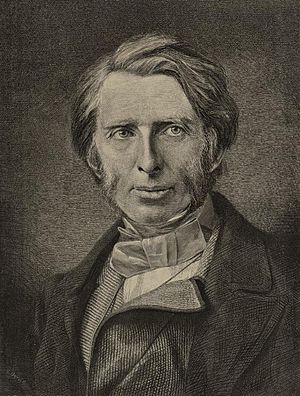
Camberwell has several art galleries. These include Camberwell College of Arts and the South London Gallery. There are also many smaller art spaces. Every summer, there is an annual Camberwell Arts Festival. The Blue Elephant Theatre on Bethwin Road is the only theatre in Camberwell.
A famous group of artists, known as the YBAs (Young British Artists), started in Camberwell. They were students at Goldsmiths' College. Many well-known artists studied there. These include Damien Hirst, Sarah Lucas, and Tracey Emin. Some famous sculptors also have studios in Camberwell. These include Mat Collishaw and Anish Kapoor.
Literature in Camberwell
Many famous writers have lived in Camberwell. Thomas Hood, a humorist, lived here from 1840 to 1842. He wrote about the clean air. The Victorian art critic John Ruskin lived at 163 Denmark Hill from 1847. He moved in 1872 because the railways spoiled his view. Ruskin Park is named after him. There is also a John Ruskin Street.
The poet Robert Browning was born in Walworth. This was then part of Camberwell. He lived there until he was 28. Novelist George Gissing walked through Camberwell in 1893. He got ideas for his writing from the life he saw there. Muriel Spark, who wrote The Prime of Miss Jean Brodie, lived in Camberwell from 1955 to 1965.
The novelist Mary Jane Staples wrote a book called The King of Camberwell. Comedian Jenny Eclair lives in Camberwell. Her 2001 novel "Camberwell Beauty" is named after the butterfly. Playwright Martin McDonagh and his brother, director John Michael McDonagh, also live here.
Nearby Peckham Rye was important for poet William Blake. When he was eight, he said he saw the Prophet Ezekiel there. He also claimed to see angels in a tree when he was ten.
Music in Camberwell
The band Camberwell Now took their name from the area.
Basement Jaxx recorded three songs about Camberwell. These are "Camberwell Skies", "Camberskank", and "I live in Camberwell". They are on their 2005 album The Singles: Special Edition.
Florence Welch from the band Florence and the Machine grew up in Camberwell. She wrote a song called "South London Forever" about her experiences. It is on her 2018 album High as Hope. She mentions places like the Joiners Arms and the Horniman Museum.
Festivals in Camberwell
Camberwell has hosted many festivals. The Camberwell Arts Festival celebrated 20 years in 2014. The Camberwell Fair takes place on Camberwell Green. It was brought back in 2015, 2017, and 2018. This fair has a very old history. It took place on the same green from 1279 to 1855. Since 2013, there is also an annual 10-day film festival. It is called the Camberwell Free Film Festival (CFFF). It is usually held in March or April.
Transport in Camberwell
History of Transport
Before the First World War, Camberwell had three railway stations. These were Denmark Hill, Camberwell Gate, and Camberwell New Road. Camberwell Gate and Camberwell New Road closed in 1916. This was due to war shortages. They never reopened.
The London Underground has planned to extend the Bakerloo line extension to Camberwell several times. This has been discussed since the 1930s.
Rail Transport
Denmark Hill and Loughborough Junction railway stations serve Camberwell. Peckham Rye and East Dulwich are also close by. All these stations are in London fare zone 2.
London Overground, Southeastern, and Thameslink trains stop at Denmark Hill. There are regular train services to many places in Central London. There are also direct links to other parts of London and the South East.
London Overground connects Camberwell to Clapham and Battersea in the west. It also goes to Canada Water and Dalston in east London. Thameslink trains go to Kentish Town in the north. Some trains go further to places like Luton Airport. Eastbound Thameslink trains go towards Orpington or Sevenoaks. They pass through Peckham and Bromley. Southeastern trains go to places in South East London and Kent. These include Peckham, Lewisham, and Dover.
Loughborough Junction is on the Thameslink route. This links Camberwell directly to places like Herne Hill, Wimbledon, and Sutton in South London. Northbound trains go through the City of London and St Pancras.
Bus Transport
Camberwell has many London Bus routes.
Notable Residents of Camberwell

Many interesting people have lived in Camberwell. The children's author Enid Mary Blyton was born nearby in East Dulwich in 1897. Karl Marx, a famous thinker, first lived in Camberwell when his family moved to London in 1849.
Other residents include Peter Preston, a former editor of The Guardian. The Guardian writer Zoe Williams also lives here. Florence Welch from the band Florence + the Machine lives in the area. Actresses Lorraine Chase and Jenny Agutter have also lived in Camberwell. Syd Barrett, one of the founders of Pink Floyd, studied at Camberwell College of Arts from 1964.
Elizabeth Patterson Bonaparte gave birth to her son, Jérôme Napoléon Bonaparte, in Camberwell in 1805. He was the nephew of Emperor Napoleon I.
Here are some other notable people connected to Camberwell:
- Tammy Abraham, professional footballer
- Henry Bessemer, inventor
- John Bostock, professional footballer
- Jeremy Bowen, BBC war correspondent
- Thomas Brodie-Sangster, actor and musician
- Joseph Chamberlain, politician, born in Camberwell
- Florence Collingbourne (1880–1946), British actress and singer
- Catherine Dean, artist
- Alfred Domett (1811–1887), New Zealand politician
- Thomas Green (1659–1730)
- Albert Houthuesen, artist
- Marianne Jean-Baptiste, British actress, director and singer
- Ida Lupino, Hollywood film actress and director, born in Herne Hill
- David McSavage, Irish stand-up comedian
- William Henry Margetson, painter
- Erin O'Connor, fashion model
- Carolyn Quinn, BBC Radio 4 journalist
- James Ring (1856–1939), photographer, born in Camberwell
- William Rust, British communist activist and journalist
- Jadon Sancho, professional footballer, lived in Peckham
- Edward Burnett Tylor, anthropologist
- Ben Watson, professional footballer
- Jack Whicher, detective
- Florence Welch (b. 1986), musician and lead singer of Florence and the Machine
See also
 In Spanish: Camberwell para niños
In Spanish: Camberwell para niños




